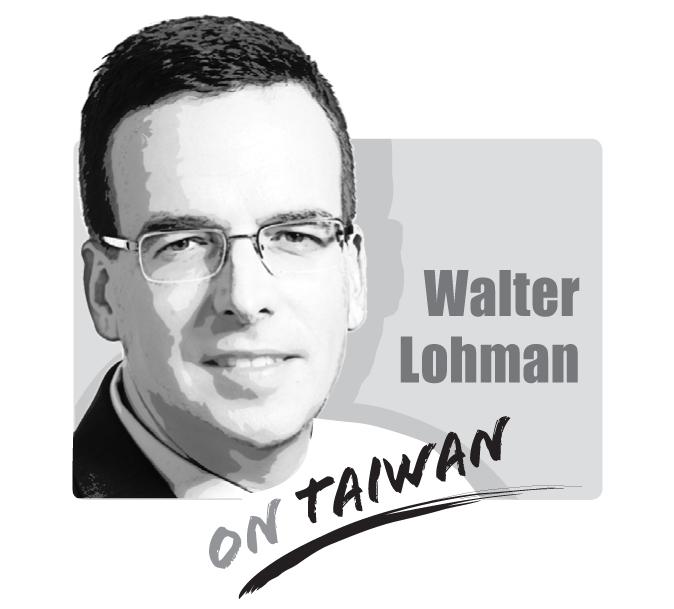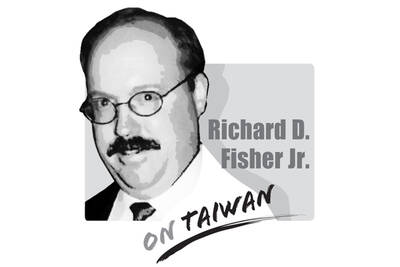In the closing weeks of 2000, an army of Singaporean government officials descended on Washington to make good on a handshake between then-US President Bill Clinton and Singaporean Prime Minister Goh Chok Tong (吳作棟). They had agreed to strike an FTA after a round of golf in Brunei that past November.
Running a small city-state, Singapore’s leaders and their diplomats live with their ear to the ground, attuned to the slightest geopolitical movements. They were motivated then by a big-picture strategic concern — keeping the US embedded in their region. An FTA they thought would help do that.
It worked. Clinton’s successor, President George W Bush picked up the trade negotiations. He sealed the deal in 2003 and went on to conclude additional high standard agreements with Australia and South Korea. He also started negotiations to enter and expand the P4 — a trade agreement involving Brunei, Singapore, New Zealand, and Chile that became the Transpacific Partnership (TPP).

Taiwan could play a similar role today that Singapore played then.
A US-Taiwan FTA could be just the thing to trigger the US to develop a robust economic component to its broader regional strategy. Initiatives like the Blue Dot Network to protect governments against bad infrastructure investments are solid. The 2019 US-Japan Trade Agreement was a good way to recoup some of the benefits of the TPP. Even the phase one US-China trade deal, if it can be fulfilled, is worthwhile. It’s better than a trade war, anyway.
The US, however, needs a bigger, more positive vision.
Taiwan would be a good catalyst for this because it is committed to liberal economic freedoms. This made the Singapore deal relatively easy, and would help with Taiwan.
Taiwan also has a strong geostrategic case. The US cannot afford to have Taiwan absorbed by China, period, now or ever — as long as the CCP is in power. It cannot afford for China to possess Taiwan’s technological capacity or the prowess of its work force. The US cannot afford to see China consolidate within the first island chain and be let loose beyond the second. On the other hand, an isolated and vulnerable Taiwan is no good either. The only way to foreclose these scenarios — in addition to maintaining the capacity of the US military to deter an attack on Taiwan — is to help it build an economic resiliency that is not overly dependent on China.
This said, the US-Singapore FTA wasn’t all about grand strategy, and neither is the case for Taiwan.
One of the more curious accusations in the trade debate over the last few years is that the US has historically traded away the economic interests of its own people for geopolitical advantage. It just not true. It was the US that provided the basic texts for the Bush-era FTAs. These had its rule-setting priorities baked in — provisions to protect American investments and promote market access beyond the explicit barriers like tariffs on goods and services schedules.
What was left to negotiate were these hard barriers. As part of the process, unfortunately, both sides had sectors to protect. But at least during the Bush years, the push was more toward gaining liberal efficiencies than protecting uncompetitive industries.
In the case of the Singapore agreement, the commitment to liberalization resulted in major increases in trade and investment. Since the FTA went into effect in 2004, US exports to Singapore have roughly doubled. Imports from Singapore have also increased, albeit more slowly. This means more opportunities for American businesses, more jobs and more choices for consumers. In terms of investment, Singaporean firms have US$21 billion invested in the US. It’s not the US$619 billion Japan has invested, but it’s ten times what it was. Meantime, US investment in Singapore has grown more than five-fold over the same period.
So with the US-Singapore FTA, exports went up, imports went up, and investment both ways went up. It happened with Australia and South Korea, too. You would be safe putting your money on a similar thing happening with Taiwan.
We are living in extraordinarily challenging times. But let us not forget, the years preceding the Bush-era free trade push were not so easy either. In the lead up to signing the agreement with Singapore, there was the Y2K scare, the 2001 recession, and of course, the 9/11 attacks and the war in Afghanistan. Then there was SARS, the bird flu, and the war in Iraq. President Bush — with a nudge from Singapore — found in economic freedom a way to forge order from the challenges. With a few adjustments, the US could do it again. This time, Taiwan can help it lead the way.
Walter Lohman is director of the Heritage Foundation’s Asian Studies Center.
On Sunday, 13 new urgent care centers (UCC) officially began operations across the six special municipalities. The purpose of the centers — which are open from 8am to midnight on Sundays and national holidays — is to reduce congestion in hospital emergency rooms, especially during the nine-day Lunar New Year holiday next year. It remains to be seen how effective these centers would be. For one, it is difficult for people to judge for themselves whether their condition warrants visiting a major hospital or a UCC — long-term public education and health promotions are necessary. Second, many emergency departments acknowledge
US President Donald Trump’s seemingly throwaway “Taiwan is Taiwan” statement has been appearing in headlines all over the media. Although it appears to have been made in passing, the comment nevertheless reveals something about Trump’s views and his understanding of Taiwan’s situation. In line with the Taiwan Relations Act, the US and Taiwan enjoy unofficial, but close economic, cultural and national defense ties. They lack official diplomatic relations, but maintain a partnership based on shared democratic values and strategic alignment. Excluding China, Taiwan maintains a level of diplomatic relations, official or otherwise, with many nations worldwide. It can be said that

Victory in conflict requires mastery of two “balances”: First, the balance of power, and second, the balance of error, or making sure that you do not make the most mistakes, thus helping your enemy’s victory. The Chinese Communist Party (CCP) has made a decisive and potentially fatal error by making an enemy of the Jewish Nation, centered today in the State of Israel but historically one of the great civilizations extending back at least 3,000 years. Mind you, no Israeli leader has ever publicly declared that “China is our enemy,” but on October 28, 2025, self-described Chinese People’s Armed Police (PAP) propaganda
Lockheed Martin on Tuesday responded to concerns over delayed shipments of F-16V Block 70 jets, saying it had added extra shifts on its production lines to accelerate progress. The Ministry of National Defense on Monday said that delivery of all 66 F-16V Block 70 jets — originally expected by the end of next year — would be pushed back due to production line relocations and global supply chain disruptions. Minister of National Defense Wellington Koo (顧立雄) said that Taiwan and the US are working to resolve the delays, adding that 50 of the aircraft are in production, with 10 scheduled for flight